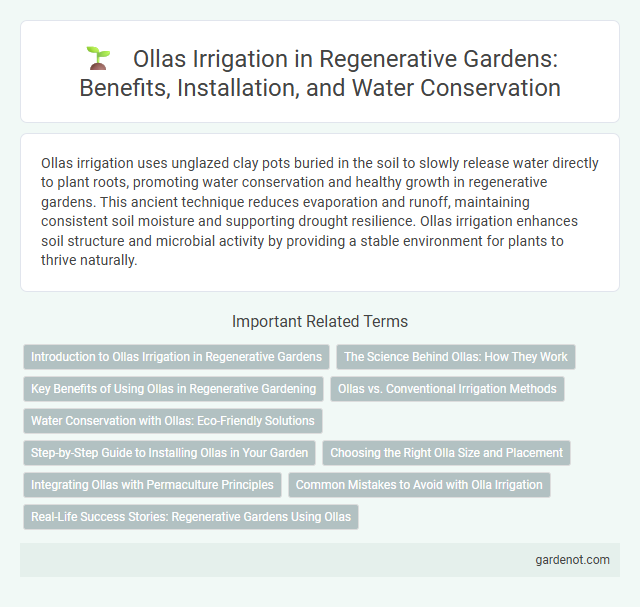Ollas irrigation uses unglazed clay pots buried in the soil to slowly release water directly to plant roots, promoting water conservation and healthy growth in regenerative gardens. This ancient technique reduces evaporation and runoff, maintaining consistent soil moisture and supporting drought resilience. Ollas irrigation enhances soil structure and microbial activity by providing a stable environment for plants to thrive naturally.
Introduction to Ollas Irrigation in Regenerative Gardens
Ollas irrigation is an ancient, water-efficient technique using porous clay pots buried in the soil to deliver water directly to plant roots in regenerative gardens. This method minimizes water waste by reducing evaporation and runoff, promoting healthier plant growth and soil microbial activity. Integrating Ollas irrigation supports sustainable water management and enhances soil structure, crucial for regenerative gardening practices.
The Science Behind Ollas: How They Work
Ollas irrigation relies on the principle of soil moisture tension, where unglazed clay pots slowly release water directly to plant roots through capillary action. The porous surface allows water to seep out only when surrounding soil becomes dry, ensuring efficient, targeted hydration and minimizing evaporation. This method optimizes water use by maintaining ideal moisture levels in the root zone, promoting healthier plant growth in regenerative gardens.
Key Benefits of Using Ollas in Regenerative Gardening
Ollas irrigation significantly enhances water efficiency in regenerative gardening by delivering moisture directly to plant roots, reducing evaporation and runoff. This method supports soil health by maintaining consistent moisture levels, fostering beneficial microbial activity, and minimizing soil disturbance. Utilizing ollas can lead to healthier plant growth, lower water consumption, and a more sustainable, resilient garden ecosystem.
Ollas vs. Conventional Irrigation Methods
Ollas irrigation utilizes porous clay pots buried in the soil to deliver water directly to plant roots, reducing water waste through evaporation and runoff common in conventional irrigation methods like sprinklers or drip systems. This ancient, sustainable technique improves soil moisture retention and promotes deeper root growth while decreasing water usage by up to 50% compared to traditional irrigation. Its low-energy, self-watering design supports regenerative gardening by enhancing soil health and fostering resilient plant ecosystems.
Water Conservation with Ollas: Eco-Friendly Solutions
Ollas irrigation uses porous clay pots buried in the soil, allowing water to slowly seep directly to plant roots, drastically reducing water waste compared to traditional methods. This water-efficient technique minimizes evaporation and runoff, conserving valuable resources in regenerative gardens. Implementing ollas supports sustainable horticulture by promoting deep root growth and maintaining optimal soil moisture with minimal input.
Step-by-Step Guide to Installing Ollas in Your Garden
Install ollas by first choosing a location near plant roots to maximize water efficiency and reduce evaporation. Dig a hole deep enough to bury the olla up to its neck, ensuring stability and easy access for refilling. Fill the olla with water and cover it with a porous lid to allow slow water release directly to the surrounding soil, promoting deep root watering and conserving moisture in regenerative garden ecosystems.
Choosing the Right Olla Size and Placement
Selecting the right olla size depends on the garden's plant water requirements and soil type, with larger ollas suitable for deeper-rooted plants and sandy soils while smaller ones fit shallow-rooted or clay-rich soils. Proper placement involves spacing ollas evenly around plants to ensure uniform moisture distribution, typically placing them 12 to 18 inches apart for vegetable gardens. Burying ollas up to their neck ensures efficient water seepage directly to the roots, reducing evaporation and promoting healthy plant growth in regenerative gardens.
Integrating Ollas with Permaculture Principles
Ollas irrigation enhances water efficiency by delivering moisture directly to plant roots, aligning with permaculture principles of resource conservation and soil health. This ancient technology reduces evaporation and runoff, promoting sustainable water management critical in regenerative gardens. Integrating Ollas supports biodiversity and natural ecosystem cycles by maintaining optimal soil moisture levels without overwatering.
Common Mistakes to Avoid with Olla Irrigation
Overwatering is a common mistake with olla irrigation, leading to waterlogged soil and root rot despite the system's design to conserve moisture. Using clay ollas with improper sealing or cracks causes uneven water distribution and evaporation loss. Positioning ollas too far from plant roots decreases irrigation efficiency, reducing plant health and yield in regenerative gardens.
Real-Life Success Stories: Regenerative Gardens Using Ollas
Regenerative gardens utilizing Ollas irrigation report significant water savings, with some users reducing consumption by up to 70% while maintaining thriving plant health. Gardeners in arid regions highlight increased soil moisture retention and improved crop yields, demonstrating the system's effectiveness in drought-prone environments. Real-life success stories emphasize the low-maintenance nature of Ollas, promoting sustainable water management in both urban and rural regenerative agriculture projects.
Ollas irrigation Infographic

 gardenot.com
gardenot.com